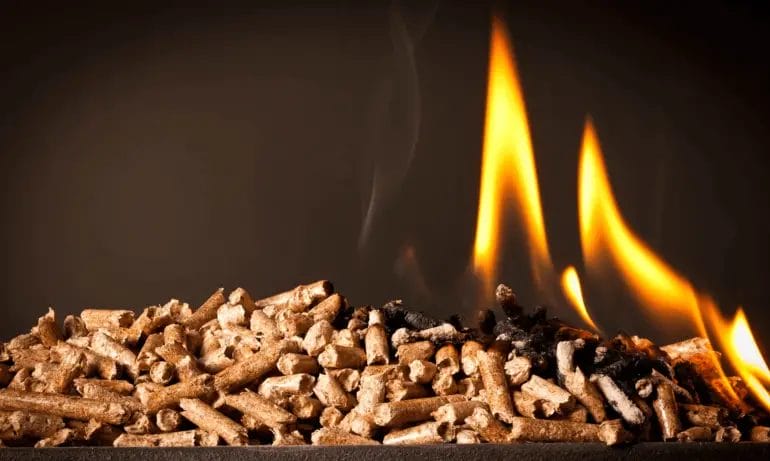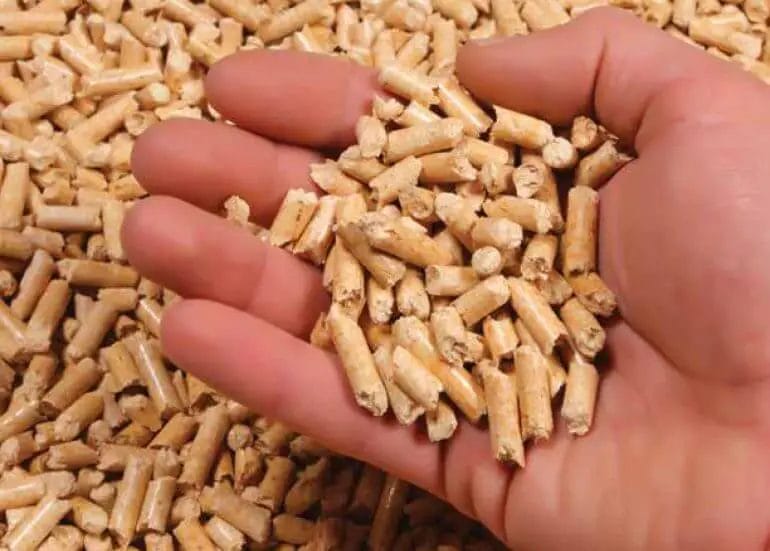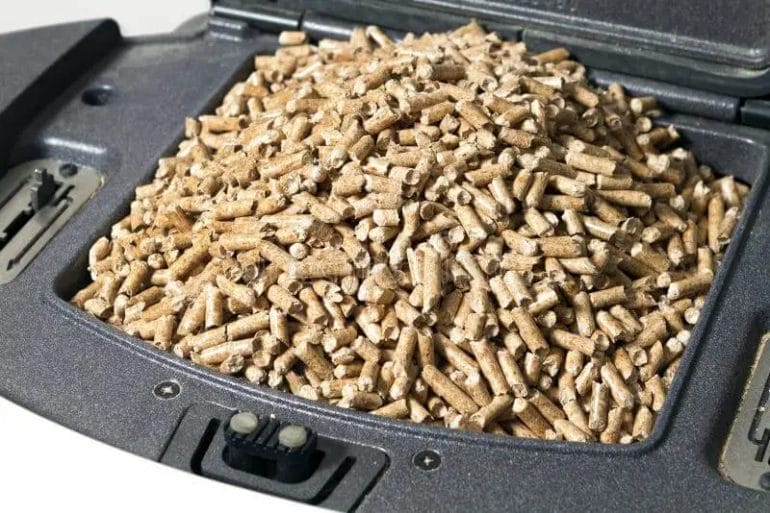Wood pellets are a popular and eco-friendly alternative to traditional fuels such as oil or gas. Made from compressed sawdust and other wood waste, these small cylindrical pellets are used for heating and cooking purposes. They can be used in pellet stoves, boilers, and grills, providing efficient heat and reducing carbon emissions. Wood pellets are also commonly used as a renewable energy source in power plants and industrial boilers. With their high energy density and low moisture content, wood pellets are an efficient and sustainable fuel option.

Environmental Benefits of Wood Pellets: An Eco-Friendly Alternative for Heating
Wood pellets have gained popularity as an eco-friendly alternative for heating. Made from compacted sawdust and other wood waste materials, these pellets offer several environmental benefits. This article explores the advantages of wood pellets as a sustainable heating option.

1. Renewable Energy Source
One of the key environmental benefits of wood pellets is that they are derived from a renewable energy source. Unlike fossil fuels, which are finite and contribute to greenhouse gas emissions, wood pellets are made from sustainably managed forests. These forests are replanted and harvested in a way that ensures their long-term health and productivity.
Using wood pellets for heating reduces our reliance on non-renewable energy sources and helps combat climate change. By opting for a renewable energy source, we can significantly reduce our carbon footprint and contribute to a greener future.
2. Lower Carbon Emissions
Wood pellets are considered carbon-neutral because the carbon dioxide released during their combustion is offset by the carbon dioxide captured by the trees during their growth. This means that burning wood pellets does not contribute to a net increase in greenhouse gas emissions.
In contrast, burning fossil fuels such as coal and oil releases carbon dioxide that has been trapped underground for millions of years. This additional carbon dioxide is a major contributor to global warming and climate change. By choosing wood pellets for heating, we can play a part in reducing carbon emissions and mitigating the effects of climate change.
3. Waste Reduction
The production of wood pellets utilizes sawdust and other wood waste materials that would otherwise end up in landfills. By repurposing these waste products, wood pellets help to reduce overall waste generation and its associated environmental impact.
Furthermore, wood pellet production creates a market for low-value wood materials, incentivizing responsible forestry practices. Instead of being discarded, these materials are transformed into a useful product, maximizing resource efficiency and minimizing waste.
4. Improved Air Quality
Wood pellets burn more efficiently than traditional firewood, resulting in reduced emissions of harmful pollutants. The combustion of wood pellets produces lower levels of particulate matter, nitrogen oxides, and volatile organic compounds compared to burning fossil fuels or lower-quality wood.
These lower emissions have a positive impact on air quality, particularly in residential areas. By choosing wood pellets for heating, we can contribute to cleaner air and reduce the risks of respiratory issues and other health problems associated with poor air quality.
5. Local Sourcing
Wood pellets are often sourced locally, reducing the need for long-distance transportation and the associated carbon emissions. By supporting local pellet producers, we can contribute to the development of regional economies and reduce our dependence on fossil fuel-dependent energy sources.
Summary
Wood pellets offer several environmental benefits as an eco-friendly alternative for heating. They are derived from a renewable energy source, have lower carbon emissions, promote waste reduction, improve air quality, and support local sourcing. By choosing wood pellets, we can make a positive impact on the environment and contribute to a more sustainable future.

Wood Pellets for BBQ and Grilling: Enhancing the Flavor of Your Food
When it comes to BBQ and grilling, nothing beats the aroma and taste of food cooked over a wood fire. While traditional charcoal and gas grills have their merits, using wood pellets as fuel can take your outdoor cooking experience to a whole new level. In this section, we will explore the benefits of using wood pellets for BBQ and grilling, and how they can enhance the flavor of your food.
1. What are Wood Pellets?
Wood pellets are small, cylindrical pellets made from compressed sawdust, wood chips, or other wood by-products. They are a popular choice for fuel in pellet grills, which are specially designed to use these pellets as a source of heat and flavor.
2. Types of Wood Pellets
There are various types of wood pellets available on the market, each with its unique flavor profile. Some common types include:
- Hickory: Known for its strong, smoky flavor, hickory wood pellets are perfect for cooking beef, pork, and poultry.
- Mesquite: Mesquite wood pellets impart a bold, earthy flavor, making them ideal for grilling steaks and other red meats.
- Apple: Apple wood pellets offer a mild, fruity flavor that pairs well with pork, poultry, and seafood.
- Cherry: With a slightly sweet and tart flavor, cherry wood pellets are great for enhancing the taste of pork, chicken, and vegetables.
- Pecan: Pecan wood pellets provide a rich, nutty flavor that works well with a variety of meats, including ribs and brisket.
3. Advantages of Using Wood Pellets
Using wood pellets for BBQ and grilling offers several advantages over other fuel sources:
- Enhanced Flavor: The natural flavors and aromas released from the wood pellets infuse into the food, resulting in a unique and delicious taste.
- Consistent Heat: Wood pellets burn evenly and provide a steady source of heat, allowing for precise temperature control and even cooking.
- Less Residue: Unlike charcoal, wood pellets produce less ash, making cleanup quick and easy.
- Wide Variety: With the availability of different wood pellet flavors, you can experiment and create diverse flavor profiles for different dishes.
- Sustainable Option: Wood pellets are made from recycled wood by-products, making them an eco-friendly choice for outdoor cooking.
4. Using Wood Pellets in Your Grill
To maximize the flavor of your food when using wood pellets, follow these tips:
- Preheat your grill and allow the wood pellets to burn for a few minutes before placing the food on the grill.
- Soak the wood pellets in water for about 30 minutes before use to produce more smoke and enhance the flavor.
- Experiment with different wood pellet flavors to find the one that complements the type of meat or dish you are cooking.
- Use a meat thermometer to ensure your food is cooked to the desired internal temperature.
- Keep a close eye on the grill while cooking with wood pellets to prevent flare-ups and maintain consistent heat.
5. Conclusion
In summary, using wood pellets for BBQ and grilling can elevate the flavor of your food and provide a unique cooking experience. With a wide range of wood pellet flavors to choose from, you can unleash your creativity and enhance the taste of various meats and dishes. So, why settle for ordinary when you can take your outdoor cooking to extraordinary with wood pellets?

Industrial Uses of Wood Pellets: From Power Generation to Animal Bedding
Wood pellets are a versatile and sustainable source of fuel that have gained popularity in various industrial applications. They are made from compacted sawdust, wood waste, or agricultural biomass, and offer a renewable alternative to fossil fuels. In this section, we will explore the industrial uses of wood pellets, ranging from power generation to animal bedding.
1. Power Generation
One of the primary industrial uses of wood pellets is in power generation. Wood pellet power plants, also known as biomass power plants, utilize wood pellets as a fuel source to produce electricity. The pellets are burned in specialized boilers, which generate steam that drives turbines, ultimately generating electricity. This renewable energy source helps reduce greenhouse gas emissions and dependence on fossil fuels.
2. Heating Systems
In addition to power generation, wood pellets are widely used as a heating source in industrial applications. Pellet stoves, boilers, and furnaces are commonly employed in commercial buildings, factories, and warehouses to provide heat during colder months. The efficiency and low emissions of wood pellet heating systems make them an environmentally friendly choice for industrial heating needs.
3. Industrial Processes
Wood pellets find application in various industrial processes. For instance, in the manufacturing sector, wood pellet fuel is used in drying kilns and ovens to facilitate the drying and curing of products such as ceramics, bricks, and textiles. These pellets provide a consistent and renewable source of heat, ensuring efficient and sustainable manufacturing operations.
4. Cogeneration
Cogeneration, also known as combined heat and power (CHP), is another industrial application of wood pellets. In cogeneration systems, wood pellets are utilized to generate both electricity and heat simultaneously. This dual-purpose approach optimizes energy efficiency and reduces waste, making it an attractive option for industries that require both electricity and thermal energy.
5. Animal Bedding
Wood pellets are extensively used as bedding material in the livestock and poultry industry. The high absorbency and natural odor control properties of wood pellets make them ideal for creating comfortable and clean bedding for animals. Whether it’s bedding for horses, poultry, or other livestock, wood pellets provide a sanitary and comfortable environment, promoting animal welfare.
Summary
Wood pellets offer a wide range of industrial uses, from power generation to animal bedding. Their versatility, sustainability, and low environmental impact make them an attractive choice for various industries. Whether it’s producing electricity, providing heat, facilitating industrial processes, generating both electricity and heat, or creating animal bedding, wood pellets prove to be a valuable and renewable resource for industrial applications.
Exploring the Versatility of Wood Pellets: From Horse Bedding to Cat Litter
Wood pellets have gained popularity in recent years as a sustainable and environmentally friendly alternative to traditional fuels. However, their versatility extends far beyond heating applications. Wood pellets have found their way into various industries, including agriculture, pet care, and household products. In this section, we will explore the versatility of wood pellets and how they are being used in innovative ways, from horse bedding to cat litter.
1. Horse Bedding
Horses require clean and comfortable bedding to ensure their well-being and prevent health issues. Traditional bedding materials such as straw and shavings can be expensive and time-consuming to maintain. Wood pellets offer an efficient and cost-effective solution for horse bedding.
Wood pellets are highly absorbent and quickly break down into sawdust when in contact with moisture. This makes them ideal for absorbing urine in horse stalls, keeping the bedding dry and reducing unpleasant odors. Additionally, wood pellets are virtually dust-free, providing a healthier environment for horses and reducing the risk of respiratory issues.
The pellets can be easily spread over the stall floor and topped up as needed. When it’s time for cleaning, the soiled bedding can be removed with ease, as the sawdust-like texture allows for efficient removal of waste. The used bedding can then be composted or used as a nutrient-rich fertilizer.
2. Animal Bedding
Wood pellets are not only suitable for horses but also for other animals such as chickens, rabbits, and guinea pigs. The absorbent nature of wood pellets helps to keep animal enclosures clean and odor-free, promoting a healthier living environment.
Similar to horse bedding, wood pellets can be spread on the floor of animal enclosures and easily cleaned when soiled. The pellets’ absorbency helps to control ammonia levels and reduce the growth of bacteria, keeping animals comfortable and reducing the risk of respiratory diseases.
3. Cat Litter
Wood pellets have also made their way into the world of cat litter. Traditional clay-based cat litters can be harmful to both cats and the environment. Wood pellets offer a safer and more eco-friendly alternative.
Wood pellet cat litter is highly absorbent and forms clumps when in contact with moisture, making it easy to scoop and dispose of waste. The natural wood fibers help to neutralize odors, keeping the litter box fresh and odor-free for longer periods.
Additionally, wood pellet cat litter is biodegradable and can be safely composted or disposed of in the garden. This reduces the environmental impact associated with traditional cat litters and promotes sustainability.
4. Household Products
Besides bedding and cat litter, wood pellets have found their way into various household products. They can be used as a natural and chemical-free alternative to absorbent cleaning products.
Wood pellets’ absorbent properties make them excellent for soaking up spills and cleaning up messes around the house. Whether it’s in the kitchen, bathroom, or garage, wood pellets can help effectively absorb liquids and prevent stains or damage to surfaces.
Furthermore, wood pellets can be utilized as a natural air freshener. By adding a few drops of essential oil to a bowl of wood pellets, you can create a fragrant and eco-friendly alternative to commercial air fresheners.
In summary, wood pellets are not just limited to heating applications. Their versatility makes them an excellent choice for horse bedding, animal enclosures, cat litter, and various household uses. By exploring the different ways wood pellets can be used, we can reduce our environmental impact and promote sustainability in our everyday lives.
FAQs
What are wood pellets used for?
Wood pellets are commonly used as a renewable fuel source for heating in residential and commercial settings. They are also used in some industrial processes and for generating electricity. Wood pellets are a popular choice due to their high energy density, low moisture content, and environmental sustainability.
Conclusion
In conclusion, wood pellets are a versatile and eco-friendly fuel source that serve a wide range of purposes. They are commonly used in household stoves and boilers as a cleaner alternative to traditional fossil fuels. The high heating value of wood pellets makes them ideal for heating homes and businesses. Additionally, wood pellets are used in industrial settings for power generation and as a renewable energy source. With their renewable nature and low emissions, wood pellets are gaining popularity as a sustainable solution for reducing carbon footprint. Whether for heating or power generation, wood pellets are an excellent choice for a cleaner and greener future.